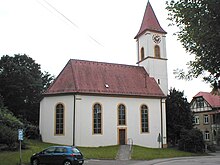Daisbach (Waibstadt)
|
Daisbach
City of Waibstadt
|
|
|---|---|
| Coordinates: 49 ° 17 ′ 40 ″ N , 8 ° 52 ′ 37 ″ E | |
| Residents : | 1318 (Dec. 31, 2013) |
| Incorporation : | July 1, 1971 |
|
Town hall, built in 1893
|
|
Daisbach is a village in the Rhein-Neckar district in Baden-Württemberg , which has belonged to Waibstadt since 1971 .
geography
Daisbach is about four kilometers north of Sinsheim and about 20 kilometers southeast of Heidelberg in northern Baden-Württemberg, in the transition area from Kraichgau to the Kleiner Odenwald .
history
Daisbach is first mentioned in a document in 1349. At that time there was already a moated castle in the village, which was probably built in the 13th century for Ministeriale der Staufer . Daisbach was probably founded around the year 700 as a Franconian royal court. The nearby Ursenbacherhof and the expired settlement of Breitenhardt have a similarly old history, but Daisbach developed into the capital with the construction of the moated castle. In 1330 the place and other Wimpfener Reichsland fell to the Electoral Palatinate . The local rule was initially held by the Lords of Venningen , in 1357 Conz von Venningen (Konrad I, † 1387) is called "Lord of Dahspach and Waibstadt". A Hans von Venningen donated the local chaplain benefice . In the 15th century the local rule passed to the lords of Rammung and the Göler of Ravensburg . After 1500 the local church was renovated, the establishment of an independent parish in 1501 goes back to Matthias von Rammung, nephew of the Speyer bishop of the same name . Bernhard I. Göler von Ravensburg carried out the Reformation in Daisbach and Daudenzell in 1522.
During the Thirty Years' War , Daisbach Castle was shot at and destroyed by Tilly on March 12, 1622 . The place was also devastated. The plague raged between 1632 and 1637 . Around 1648 there were still five middle class families (approx. 20-25 inhabitants) in Daisbach. In the following decades only a few new citizens settled. A Lutheran parish was only founded again in 1722 and it was not until 1730 that Karl Eberhard Göler of Ravensburg († 1732) began to rebuild the castle.
In the middle to the end of the 19th century, over 70 people migrated from Daisbach to Marion in the US state of Wisconsin, where 29 households with a migration background from Daisbach existed up to 1910.
During and after the Second World War, the population of the until then purely agricultural town grew strongly due to the influx of refugees and displaced persons. In 1939 there were 529 inhabitants, at the end of 1945 there were 695 and in 1947 there were 866 inhabitants. On July 1, 1971, the place was incorporated into Waibstadt .
Buildings
- The Daisbach moated castle goes back to a high mediaeval moated castle that was destroyed in the Thirty Years War and only partially rebuilt from 1730 to 1732. An inscription plaque above the portal dated 1730 reminds of the reconstruction under Carl Eberhardt Ludwig Göler von Ravensburg. The makeshift roof collapsed in 1840 and the structure then fell into disrepair. In 1957 the owner opposed the demolition ordered by the community because of dilapidation and was sentenced to a fine. In 1983 the city of Waibstadt acquired the castle ruins and the surrounding small park. The ruin is now open to the public. In the cemetery there are several historical grave monuments of the lords of the castle, the Barons Göler von Ravensburg .
- The old castle is a stately property located above the castle ruins.
- The Protestant church was built from 1786 to 1788 and replaced a previous building that was closed in 1784 due to disrepair. The bell tower was added in 1937. The historical grave slab of Ursula von Rammung († 1502) was found on the outer facade in 1967 . The Protestant rectory from 1907 is located near the church .
- The foundation stone of the Roman Catholic Church of the Visitation of the Virgin Mary was laid on May 1, 1962. After only one year of construction, the church was ceremoniously consecrated. The church building is 15.59 meters long, 11.50 meters wide and 5.70 meters high. Architect Carl Herb from Nussloch was responsible for building the church. The patronage (Visitation of the Virgin Mary) is celebrated on July 2nd.
- The town hall was built as a schoolhouse in 1893.
- Numerous other historical buildings have been preserved in the town center. The old town hall was built in 1847. The old rectory was built by Pastor Feßenbeck in 1835 and acquired by the manor in 1836. Until 1832 there was a previous building on the site of today's town hall. The Gasthaus Adler was built in 1835, the Gasthaus Krone was acquired by the community as a school in 1819 and only later became a restaurant.
- The village fountain was built in 2002.
- The Ursenbacherhof is a historic farm complex outside of Daisbach. After various renovations, the oldest building there only dates from 1840. A historical oak fountain south of the Ursenbacherhof was redesigned in 2004.
Individual evidence
- ↑ Daisbach site
- ↑ Eberbach: City Archivist Marius Golgath met with research on an expatriate network. Retrieved March 27, 2020 .
- ↑ Communications from the Württ. And Bad. State Statistical Office No. 2: Results of the population census on December 31, 1945 in North Baden
- ^ Federal Statistical Office (ed.): Historical municipality directory for the Federal Republic of Germany. Name, border and key number changes in municipalities, counties and administrative districts from May 27, 1970 to December 31, 1982 . W. Kohlhammer, Stuttgart / Mainz 1983, ISBN 3-17-003263-1 , p. 479 .
literature
- Wolfgang Vögele: Daisbacher Chronik 1993. Waibstadt 1993.
- Heinrich Steidel: Local history of Daisbach with Ursenbacherhof. Heidelberg 1910.








